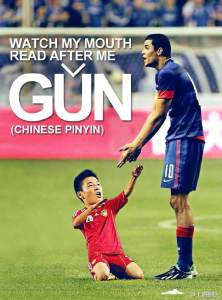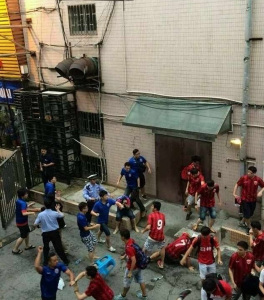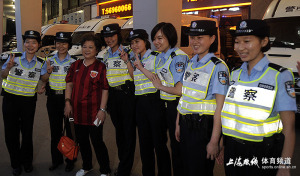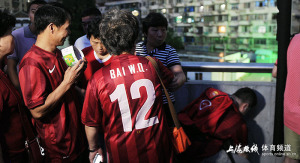Following an unexpectedly intense derby between Shanghai Shenhua and Shanghai East Asia, ‘s Cameron Wilson takes an in-depth look at the big changes in the Shanghai football landscape this year and how the fixture’s influence may spread beyond the city itself.
For about a decade now Shanghai football has had little to shout about. Shenhua’s well-documented decline has shamed the city for years, whilst no other team has been able to make any impact on the local scene.
Shanghai Shenxin float each year from one empty stadium to the next, whilst Shanghai East Asia’s relegation-avoiding start to their CSL life last year was only modest progress for football in the city.
But at the start of this year the winds of change blew new investment into Shanghai’s two biggest clubs. Greenland’s takeover came too late to mend Shenhua’s threadbare squad before the season began, but Shanghai International Port Group’s investment transformed East Asia from relegation strugglers into genuine Asian Champions League (ACL) qualification contenders.
Suddenly another team in the city was poised to capitalize on Shenhua’s long period of mediocrity to become Shanghai’s top team. The first derby of the season saw 22,000 fans turn out for a match which started off in mild fashion but ended with a horrendous tackle on Gio Moreno and a sending off for each side in the resultant brawl. And so the scene was set for the second derby of the season.
Expectations were limited by the fact the it was only the fourth competitive fixture between the two clubs. Yet anticipation levels among both sets of fans were nevertheless high. In the south of the city, East Asia were desperate for a first ever league win over Shenhua to keep alive their ACL bid. In northern Hongkou district, Shenhua fans had endured a dull season, so looked forward to the final big home game of the year, eager to see last season’s “Derby Kings” make amends for a humiliating first-ever home loss to Beijing Guoan several weeks earlier.
There’s always a great match day buzz around Hongkou, but before this derby, there was something particularly tangible in the air. In the days leading up to the match, banter was exchanged between the fans online with witty memes, raising the temperature somewhat. Indeed the sponsor name of East Asia is Shanghai Shanggang, with the “gang” meaning port or harbour. However this word in Chinese sounds very similar to the Shanghainese term for “stupid” – so Shenhua fans amused themselves by using that character instead to refer to their rivals on social media.
At lunchtime on matchday, pictures of vast numbers of riot police arriving at Hongkou were circulated on social media, raising the tension a little. Then around 90 minutes before the game, an action photo (below right) of two sets of fans going toe-to-toe in an alleyway near Hongkou swept Weixin (Wechat) like wildfire and was the talk of everyone as they made they way to the ground – things had kicked off indeed.
The pre-match tension was inevitably released inside the stadium. A full on game not short on controversial moments was roared on by a large crowd with a significant number of away fans. Indeed the East Asia supporters were situated within earshot of the north terrace, also close enough for the many rude and aggressive gestures made by the two groups towards each other to be clearly visible by both sides.
Indeed, this large number of away fans which was key to the Shanghai Derby achieving “level up”, and adding fuel to the rivalry fire. Last year’s fixture was notable for the relative lack of East Asia supporters in Hongkou – their showing was outnumbered by that of several other clubs not even based in Shanghai, mainly Hangzhou and Jiangsu Sainty. But this year the Xuhui side comfortably brought the biggest away showing this time, two full sections in the upper and lower tier at least.
The visitors were in full voice. Again in contrast to previous fixtures, the chanting had an edge to it – Shenhua being directly abused by the East Asia crowd before a ball had even been kicked. Something was in the air alright – it seemed more hostile than last time before a ball had been kicked.
There had been some speculation beforehand that Shenhua would “lie down” and do their rivals a favour in the ACL race, and when foreign strikeforce Paulo Henrique and Lucas Viatri were not named in the matchday squad, your correspondent feared the worst.
However, the match itself dispelled any such rumours – both teams went hard at it from the off. Shenhua taking the lead silenced East Asia’s noisy fans and raised the stakes. East Asia’s support gleefully began celebrating when Wu Lei was felled by Xu Liang to win a penalty – but in a moment of classic derby drama, Qiu Shenjiong saved the resultant spot-kick, as the Shenhua faithful went nuts to pump up the volume even higher. In the aftermath of the save, Qiu made an aggressive throat-slitting gesture which delighted the home support as Shenhua’s lead remained intact.

Post penalty save – excited Shenhua keeper Qiu Shenjiong perhaps indicating a preference for halal meat.
At half-time your correspondent and his match-going companions emerged breathless onto the concourse in search of liquid refreshment. And for once, everyone couldn’t wait to get back in for the second half. Things perhaps inevitably couldn’t remain quite as frantic in the second half, but East Asia’s lucky yet deserved equalizer delighted the away following whilst muting the home support somewhat.
The tension continued right to the end as the away side pressed for a winner which ultimately didn’t come, and by the time the final whistle went, it seemed everyone in the entire stadium was exhausted.
Looking back, it was fairly clear the seeds of rivalry between Shenhua and East Asia had been well-planted, but surely no-one expected things to bloom quite so quickly. Speaking as someone who has attended hundreds of derbies, many of them in countries with football histories stretching much further back than China’s, the last Shanghai Derby was up there with the best of them in terms of atmosphere and intensity.
To understand how this new rivalry has developed so fast we need to look at the many other clubs over the years which have tried to usurp Shenhua from the Shanghai footballing throne, clubs which, one way or another, were all seen off by Shenhua.
Shanghai Zobon? They started life in Zhuhai in Guangdong and never attracted a crowd. Shanghai United? Struggled to build any support despite Zhu Jun’s best efforts, before being “merged” into Shenhua.
Shanghai Shenxin? Abandoned Shanghai for Nanchang for a few years before coming back, but still change stadium every year and shamelessly imitate their big brother’s colours and name, whilst obviously falsifying their crowd figures.
Inter Shanghai of course were the first team to offer Shenhua a local rival worthy of respect and back in the early 2000s was a chief participant in the first proper city derby in Chinese football. Inter molded themselves as the city’s most “Shanghainese” team by luring several of Shenhua’s top names and it was a strategy that worked – for a while. They averaged crowds of around 17,000 at the cavernous Shanghai stadium for a couple of years, but ultimately they lost momentum. Their support dwindled to a few thousand per match before the club moved to Xi’an in 2006.
Derbies are all about local pride – the key word here is “local.” This is why the Shanghai Derby is back with a vengeance. And what is unique about this derby is that Shanghai East Asia have proper local roots they have developed organically – the club started in the third division in 2005 and worked their way up the leagues slowly attracting more fans each year. It could be said Inter Shanghai started from humble beginnings in the lower leagues at Chuansha stadium in Pudong district. But of course they changed names and colours several times before finally leaving town.
One can never say never in Chinese football, but its hard to imagine East Asia moving away from Shanghai. Established by the godfather of Shanghainese football, Xu Genbao, with a playing squad featuring a large percentage of Shanghai-born players recruited from the club’s academy on Chongming Island, and you have a club with deeper Shanghai roots than any other pretender to Shenhua’s crown.
These elements add authenticity to the Shanghainese flavour of the derby. A diverse cast of local characters were present including Shanghai-born former Inter and Shenhua player Fan Zhiyi – one of China’s greatest players, and Shenhua legend Xie Hui, as well as local TV personality and celebrity East Asia fan Bai Wanqing, affectionately known as “Aunt Bai” to the away support.
In fact, Bai’s contribution to the occasion was very much focused on the front line. According to local media reports, she mediated in the much publicized rumpus between both sets of fans before the match, “Don’t fight! We are all Shanghainese here,” implored Bai. However her pleas “fell on deaf ears” – both groups carried on their shenanigans regardless, as the middle-aged female fan was escorted from the scene to safety, understands.
Between the two clubs there is considerable cross-over. Shenhua’s Zhan Yilin, Bai Jiajun and Cao Yunding, all Shanghainese, and Hubei native Zheng Kaimu are all former East Asia players. Most recently, former England keeper Ian Walker moved in the opposite direction to be goalkeeper coach down in Xujiahui, following former Shenhua boss Xi Zhikang who is now East Asia head coach. But of course everyone knows Xu Genbao, the man who delivered Shenhua’s first and only league title, not only pulls the strings as head coach, but established the entire club.
The defections are not only limited to playing and coaching staff. Capo for the curiously-named Bat Rider East Asia fan’s group is none other than Xiao Ba, a former Shenhua Blue Devil – he was paid by an unknown financial backer as a man with experience to lead a new group whose emblem bears a striking resemblance to the Bacardi drinks brand.
Such switching of allegiance may be heresy in traditional football countries, but it’s nothing new here – much of the animosity between Inter Shanghai and Shenhua back in the day was because, as understands, some Shenhua fans were paid to join a new fan group to support Inter. So with players, coaches, and even fans having represented both sides, in hindsight it perhaps wasn’t surprising the derby turned out to be a a fiery encounter.
On the subject of local derby participants, one of Shanghai Shenxin’s few redeeming features is that they have the highest number of Shanghainese players of all the Shanghai clubs. This could be a great positive for any derby fixture, but that only works if the team is winning regularly, or if the players are very talented, or if they are are big names. Shenxin fail on all counts, but East Asia don’t and are flying high. It is their impressive achievements on the pitch which have led to the return of a proper Shanghai Derby sooner than anyone imagined.
As China’s original derby city, Shanghai has a relatively long history of having more than one top league club, and East Asia surely have quite a few former Inter fans amongst their rank as well as other local football lovers who like to watch games live in the stadium but for reasons which aren’t hard to imagine don’t want to watch Shenhua.
Shanghai East Asia are a club with solid roots and on the up – and with Shenhua sure to invest heavily in the transfer market next season, the Shanghai Derby is only going to be even bigger next year.
After years of underachievement, Shanghai football finally has something to be proud of. Dalian had it for only one season, and Guangzhou has it but R&F has no roots in the city and is sometimes supported by off duty fans of their rivals Evergrande. Only Shanghai has a proper city derby with two clubs deeply-rooted in their communities which enjoy significant backing on the terraces. This new Shanghai derby is one which adds much needed culture and lore to a relatively young league lacking both and, and sets the standard for future derbies in other Chinese cities to follow.
The derby is Shanghai football’s biggest contribution to the game in China in recent times, and forms a solid platform for healthy competition between Shenhua and East Asia to help bring greater footballing achievements to the city in the coming years.





